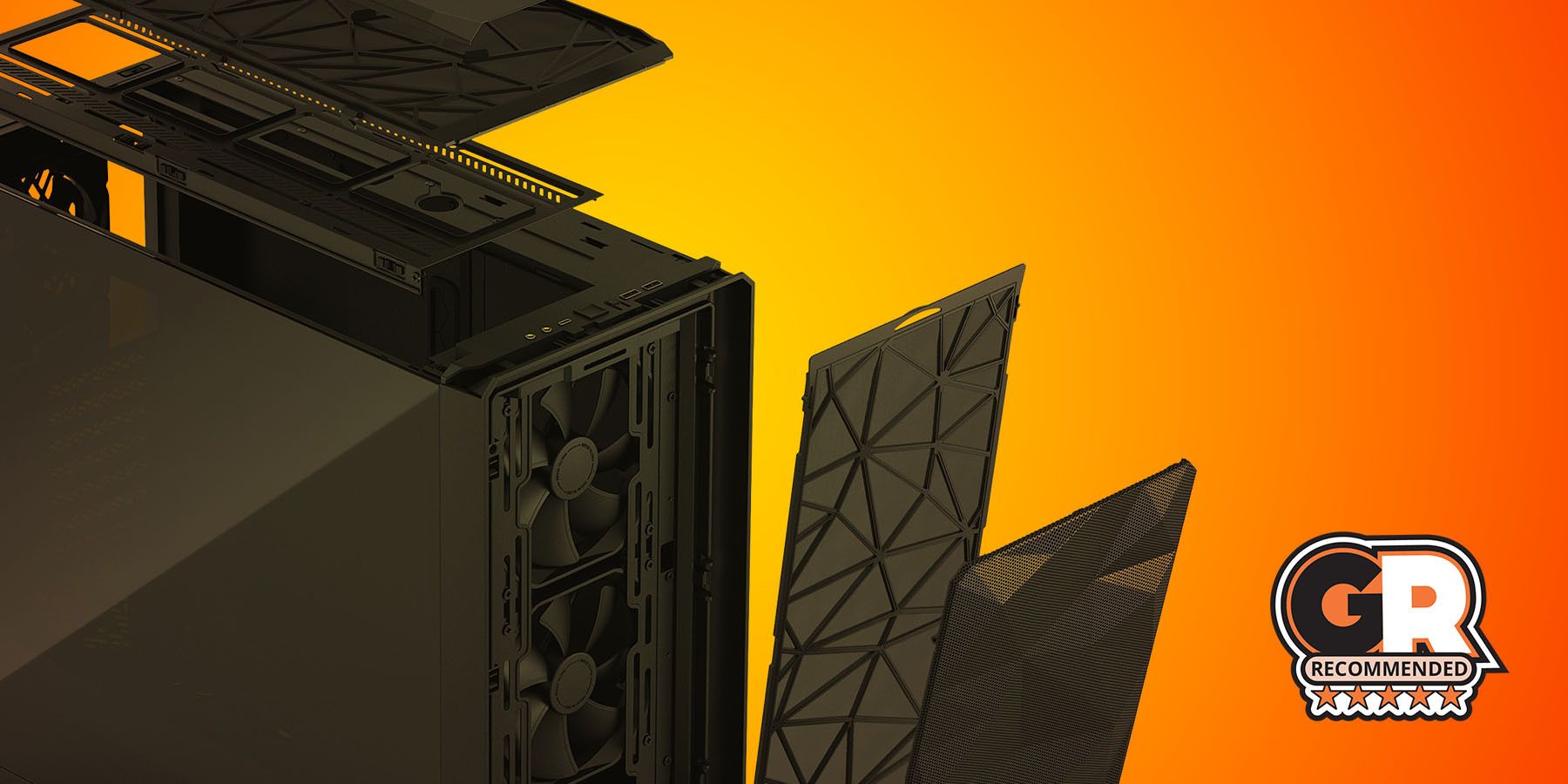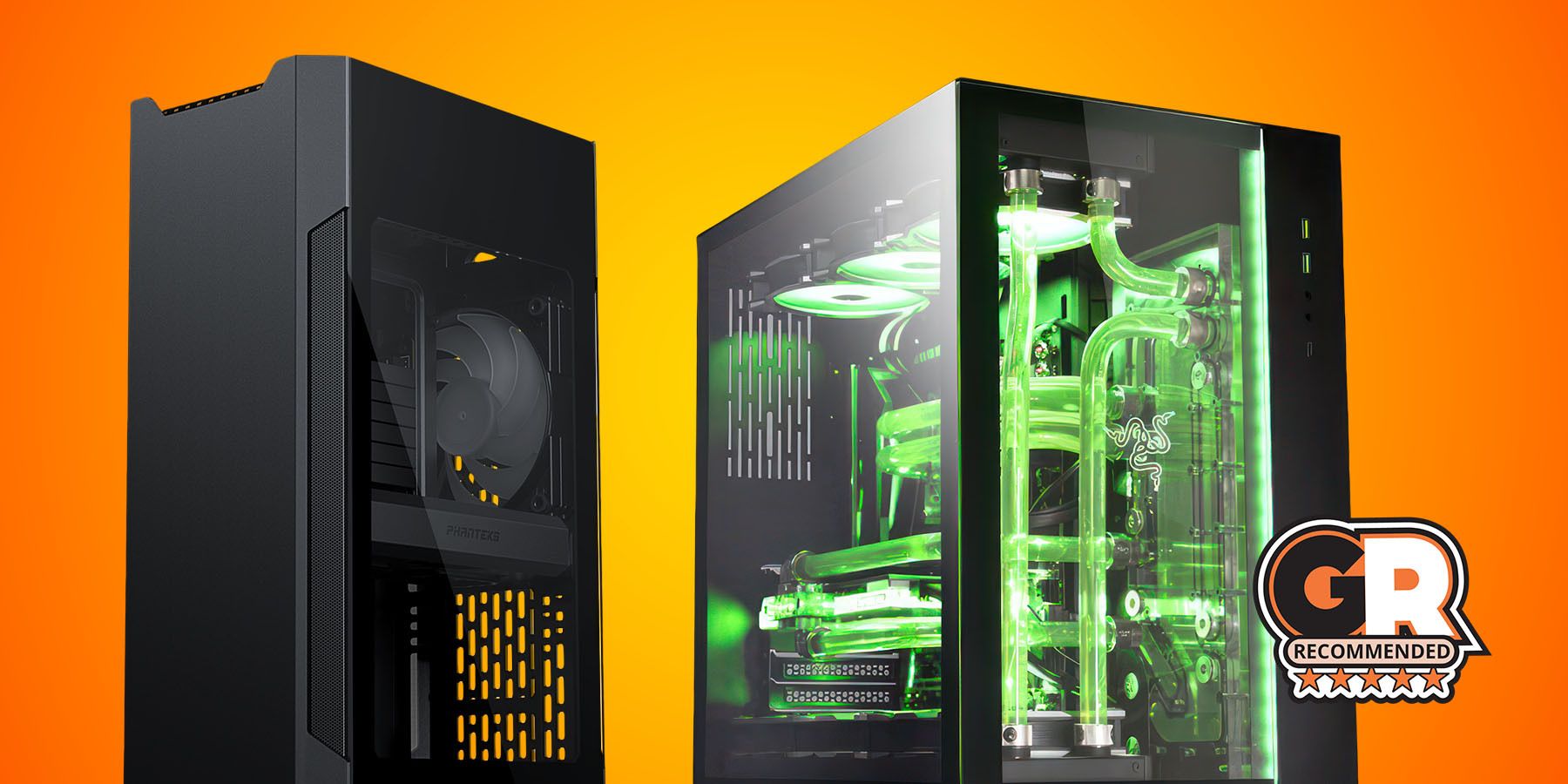Buyers have many priorities when shopping for a case, but the best PC cases for airflow can increase the lifespan of critical components. With more gamers than ever now overclocking CPUs, GPUs, and memory, an excess of heat can quickly build up inside a case. As a result, manufacturers have emphasized thermal performance more with cases, employing several different strategies for effective cooling.
-
Corsair 4000D Airflow
Best Overall PC Case for Airflow
-
Fractal Design Meshify 2 Compact
Best Compact Mid-Tower PC Case for Airflow
-
MSI MPG Gungnir 300R Airflow
Best Mid-Tower PC Case for Airflow
-
Phanteks Enthoo Pro 2
Best Full-Tower PC Case for Airflow
-
Cooler Master MasterBox NR200P
Best Small Form Factor PC Case for Airflow
How to Find the Ideal Case for Controlling Temperatures
Considerations like build quality and aesthetics undoubtedly will become factors when shopping for any case. However, when cooling is the priority, these qualities should concern buyers before any others:
- Filters and Vents: Many PC cases have mesh filters or perforations on their front panels to allow more air to enter rigs. With cases that encourage ample airflow, it’s also common to find dust filters, vents, and other openings placed on all sides of an enclosure.
- Case Fan and AIO Liquid Cooling Support: In many instances, ventilation alone cannot keep temperatures down inside a case. Consequently, some cases accommodate a vast array of case fans and AIO liquid coolers. The ideal case for cooling is flexible enough to allow for a configuration that draws cooler air into a chassis, and exhausts heat from CPU coolers and GPU fans.
- Form Factor: How large or small a case is doesn’t necessarily dictate how easy it is to cool the components inside. Even so, it’s usually more difficult to find generous cooling pathways in compact mini ITX cases. On the other hand, larger mid-tower and full-tower cases boast more unobstructed areas to blow air around a chassis.
- Cable Management: Organizing cables inside a case isn’t the first thing system builders concern themselves with trying to increase thermal performance. Even so, thicker cables can block airflow, particularly in compact cases without practical cable routing options.
With these general guidelines in mind, both novice and experienced system builders can find suitable cases with unlimited cooling potential.
Game Rant’s picks for the Best PC Cases for Airflow

Corsair 4000D Airflow
Best Overall PC Case for Airflow
The CORSAIR 4000D AIRFLOW is a mid-tower ATX case with easy cable management and exceptional cooling. A steel front panel with triangular cutouts offers optimal airflow to components, accompanied by two included 120 mm AirGuide fans designed with anti-vortex vanes that enhance cooling. The CORSAIR RapidRoute cable management system makes it effortless to route major cables through a single channel, with 25mm of routing depth.
- Brand
- Corsair
- Motherboard Size (Max.)
- ATX
- 3.5″ Drive Slots
- 2 x Internal 3.5″
- Viewing Window
- Yes
- 2.5″ Drive Slots
- 2 x Internal 2.5″
- Graphics Card Size (Max.)
- 360 mm / 14.173″
- Triangular cutouts used through case to promote airflow
- Excellent build quality
- Better thermal performance than more expensive cases
- Single-channel cable management doesn’t block cooling
- Only two fans ship with case
- Just one USB 3.0 port on top I/O panel
The Corsair 4000D Airflow is ideal for system builders looking to achieve excellent cooling performance without spending an enormous amount of money. While its pricing often sends it into the budget case category, the build quality and thermal performance of the case outperform its more expensive rivals.
For buyers who dislike triangles, the Corsair 4000D Airflow is a bit of a nightmare. Triangular cutouts dominate this mid-tower case, including on its front panel, backside PCI slot covers, and the PSU shroud cover inside the chassis. This design promotes airflow and gives the case a unique look compared to most mesh-dominated alternatives. The Corsair 4000D Airflow boasts stellar build quality, with a healthy amount of steel throughout the enclosure. A tempered glass left panel would seem to limit cooling potential, but buyers will appreciate that the component feels like a solid piece of glass rather than hard plastic.
Corsair keeps the asking price of the 4000D Airflow reasonable in part because they only include two fans. However, the pair of Corsair 120 mm AirGuide fans can do the work of a larger assortment of fans by outputting highly concentrated blasts of air throughout a case. Buyers can add four more 120 mm fans on the front, top, or back of the case. AIO liquid coolers are also welcome, though 360 mm configurations are limited to the front panel, with the top of the case accommodating 240 mm radiators.
The 4000D Airflow is a mid-tower case that leans toward being slightly more compact than some of its competition. Still, there is plenty of room behind the motherboard tray to route cables, which can eliminate any chance of messy wiring interfering with cooling. Unfortunately, some system builders may find the top I/O panel a bit too minimalist since there are only single USB 3.0 and 3.1 ports.
Ultimately, the Corsair 4000D Airflow stakes its reputation on its cooling performance. Thankfully, it doesn’t disappoint. Unique triangular openings throughout the 4000D Airflow allow more air to enter and leave the case than high-end builds with mesh materials. The Corsair 4000D Airflow ranks higher than any of the best PC cases for airflow, with a thermal performance that far exceeds its reasonable asking price.
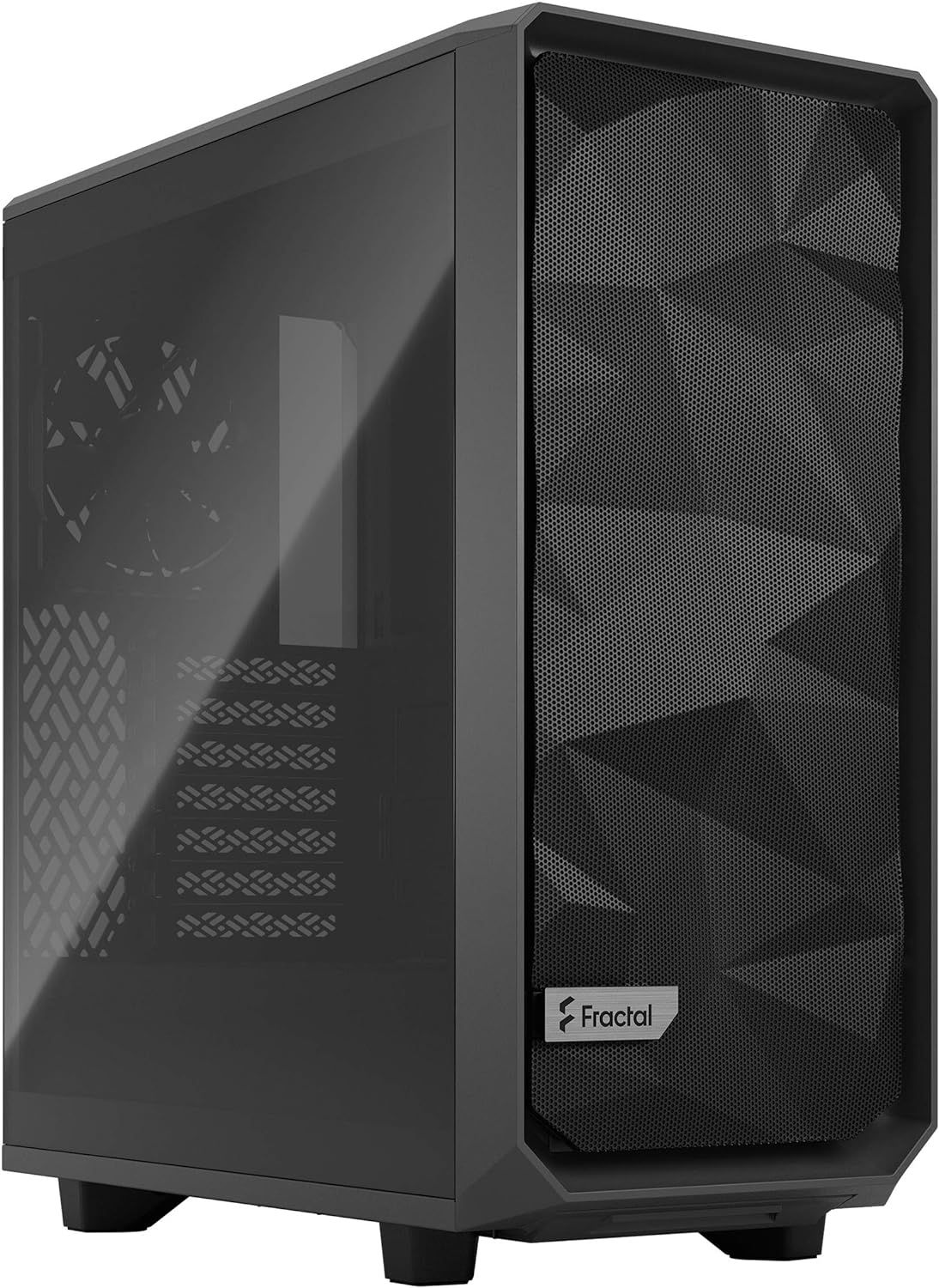
Fractal Design Meshify 2 Compact
Best Compact Mid-Tower PC Case for Airflow
The Meshify 2 Compact is a high-performing case with a bold, stealth-inspired aesthetic. Its striking exterior features bolt-free, flush tempered glass, a fully removable top panel granting excellent interior access, and a front USB 3.1 Type-C port. Users can install up to seven fans, front radiators up to 360 mm, or top radiators up to 240 mm for robust cooling.
- Brand
- Fractal Design
- Material
- Steel, Tempered Glass
- Graphics Card Size (Max.)
- 341 mm
- 3.5″ Drive Slots
- 2
- 2.5″ Drive Slots
- 2 included, 4 positions total
- Power Supply Size (Max.)
- 200 mm
- Exterior Dimensions
- 424 x 210 x 475 mm
- Motherboard Size (Max.)
- ATX / mATX / Mini-ITX
- Angled mesh adds a welcome spin on typical front panel designs
- Front dust filter removable to enhance airflow
- Includes three powerful fans
- Lacks screwless hard drive tray
- Lightweight construction makes cases feel less premium
As cooling performance became more of a priority among gamers, mesh materials began to dominate cases. The Fractal Design Meshify 2 Compact includes a front mesh panel that stands out from the crowd thanks to an angular pattern that pops out from the surface of the case. On the front of the case, buyers can remove the nylon filter, which maximizes airflow without ruining the overall design. This compact mid-tower case also extensively uses dust filters on the front top and bottom of the enclosure, and all are easily accessible for quick cleaning.
With the Fractal Design Meshify 2 Compact, buyers receive one 120 mm and two 140 mm fans, which is rather generous for a smaller mid-tower case. These fans rely on extremely durable bearings which allows the fans to long outlast other parts in a build. The Meshify 2 Compact also is flexible when adding fans, with room for up to seven 120 mm fans on all sides of the case. Fans of liquid cooling don’t have to fret since the case also provides installation points for a front 360 mm or top-side 240 mm radiator.
The Meshify 2 Compact is carefully designed so that the front fans can blow air into the case and directly over vital components like M.2 SSDs and, most importantly, powerful CPUs. This air is then sent speedily toward the included rear fan to be exhausted out of the case. Of course, system builders are free to modify the cooling layout, and working inside the surprisingly spacious chassis is easier with a removable top panel.
Despite the praise that the Fractal Design Meshify 2 Compact often receives, there are a few negatives worth mentioning. Screwless hard drive bays, which have become almost standard in modern cases, are not found here. Also, while the Fractal Design Meshify 2 Compact has a premium look, it’s quite lightweight, making its price tag seem excessive. Regardless, the manufacturer has made reducing CPU and GPU temps as simple as possible with an easily accessible and modifiable design.

MSI MPG Gungnir 300R Airflow
Best Mid-Tower PC Case for Airflow
$149 $170 Save $21
The MSI MPG Gungnir 300R is a mid-tower case with an emphasis on promoting a steady stream of airflow through its chassis. The front panel features a single-piece mesh design with the case allowing for up to two 360 mm AIO liquid coolers or 12 fans. An adjustable omnidirectional graphics card holder makes vertically mounting even RTX 4000 series GPUs simple and secure.
- Brand
- MSI
- Material
- Steel, Mesh, Plastic
- Graphics Card Size (Max.)
- 360 mm
- 3.5″ Drive Slots
- 2
- 2.5″ Drive Slots
- 8
- Power Supply Size (Max.)
- 200 mm
- Exterior Dimensions
- 235 x 505 x 510 mm
- Motherboard Size (Max.)
- EATX(Up to 305 x 280 mm)
- RGB Lighting
- ARGB
- Viewing Window
- Yes
- Innovative omnidirectional GPU holder
- Includes 4 ARGB fans
- Large front mesh panel plus numerous vents
- Thermal performance more ordinary with horizontal GPU mounting
- Some accessories take trial and error to benefit from
Manufacturers now take a liberal approach as to what constitutes a mid-tower case. The MSI MPG Gungnir 300R is a standard-sized mid-tower larger than the company’s budget-friendly MAG Forge 112R but more compact than the giant MEG Prospect 700R. Buyers can find less expensive cases that cool components just as well, but the MPG Gungnir 300R offers solutions to certain builds where cooling is especially difficult.
One of the obvious selling points of the MPG Gungnir 300R is its included omnidirectional GPU holder. This component can move in several directions and includes brackets resting on the top and bottom of the largest graphics cards. The holder is most appealing for vertical GPU mounting, which often requires purchasing an extra kit with a PCIe riser cable. Vertical PCI slot brackets are easily installed at the rear of the case, and MSI even includes a small fan to take advantage of the added cooling pathway. The MPG Gungnir 300R is quite friendly to ARGB lighting, shipping with a controller unit, and the GPU holder is also illuminated along the same lines.
Vertical GPU mounting is a creative way to create new cooling pathways in a case, but its execution can ironically endanger the graphics card itself. However, the MPG Gungnir 300R leaves enough gap between its tempered glass left panel and a graphics card for the GPU not to overheat. Numerous other aspects of the case also encourage airflow, most notably the perforated front panel that juts out at an angle. MSI also placed a large vent toward the top edge of the case’s front side and air holes on the right panel. Not to be overlooked are the four included ARGB fans, which softens the somewhat steep asking price of the MPG Gungnir 300R.
Most of the appeal of the MPG Gungnir 300R lies in its creative and highly adjustable GPU mount. Otherwise, the cooling performance of a system will not be significantly higher than that of a typical mid-tower case. Nevertheless, with excellent build quality and some modular components that a buyer would expect to find on the most premium offerings, the MPG Gungnir 300R is one of the best PC cases for airflow.
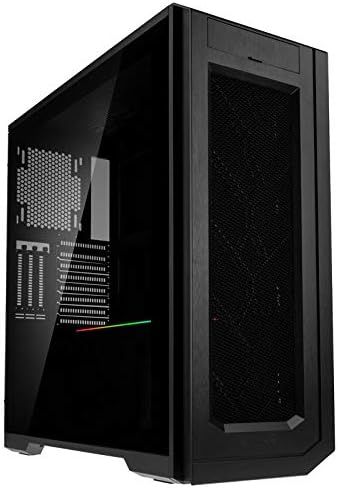
Phanteks Enthoo Pro 2
Best Full-Tower PC Case for Airflow
$150 $170 Save $20
The Enthoo Pro 2 has been designed with extreme performance in mind, featuring Phanteks’ innovative High-Performance Fabric that sets a new airflow performance standard in the PC enclosure industry. With an incredibly spacious interior, the Enthoo Pro 2 supports up to SSI-EEB motherboard, dual 480 and dual 360 radiator support simultaneously, dual vertical GPU support, and dual system/PSU support.
- Brand
- Phanteks
- Graphics Card Size (Max.)
- 503mm
- 3.5″ Drive Slots
- 12
- 2.5″ Drive Slots
- 11
- Exterior Dimensions
- 22.8 x 9.5 x 22.0 inches
- Motherboard Size (Max.)
- SSI_EEB
- RGB Lighting
- Optional
- Viewing Window
- Yes
- Unique mesh fabric outperforms other materials
- Large enough to install two PCs
- Tremendous expansion potential for its price
- Includes no fans
- Build quality could be better
Whether a buyer is putting together a full-fledged file server or has a lot of hard drives in use, a full-tower case like the Phanteks Enthoo Pro 2 can be the solution. Large cases are sometimes intimidating, but Phanteks has made it relatively straightforward for novices to maximize the potential of the Enthoo Pro 2. Also, because of a unique mesh fabric made from nylon materials, the case can match the thermal performance of any full-tower case on the market.
To avoid any disappointment, the Enthoo Pro 2 doesn’t ship with any case fans. Since the case can hold up to fifteen 120 mm fans or eight 140 mm fans, fully decking out the chassis with cooling can become expensive. The good news is that even with adequate CPU cooling and limited additional fans, the Enthoo Pro 2 has posted impressive cooling benchmarks. An effective AIO liquid cooling system is more than sufficient for keeping system temperatures down, and this case can even have up to 480 mm radiators on its front or to the right of the motherboard tray. Responsible for amplifying airflow in the case, the high-performance mesh fabric on the front panel has larger openings than typically seen. Numerous dust filters are scattered around the case that further enhance airflow and simplify cleaning the system.
With the Enthoo Pro 2, buyers can install an insane amount of storage. By default, it’s possible to use up to 11 SSDs and four 3.5-inch hard drives, with more options after purchasing additional brackets. Even more impressive is that placing an additional mini-ITX system at the bottom of the case is encouraged. This allows gamers to have a dedicated server and gaming machine without purchasing an excess of parts. To run two PCs in the Enthoo Pro 2, system builders must purchase a power supply designed to connect to two systems, like Phanteks Revolt X.
The Enthoo Pro 2 has a minimalist look despite having plenty of space for ports and buttons. It might take a moment for users to find the front I/O panel, which flips open to reveal four generous USB 3.0 and one USB-C Gen 2 port. The case is sold in variations, including a tempered glass panel, which can showcase a massive build in its full glory. Not designed for just servers, the Enthoo Pro 2 also has an onboard RGB controller to add an onslaught of illuminated fans and light strips.
Falling short of the tank-like build quality that some buyers might expect from a full-tower case, the Enthoo Pro 2 is still durable enough to survive its five-year limited warranty period. Capable of cooling components with only a bare-bones fan configuration, the Phanteks Enthoo Pro 2 is one of the best PC cases for airflow among full tower contenders.
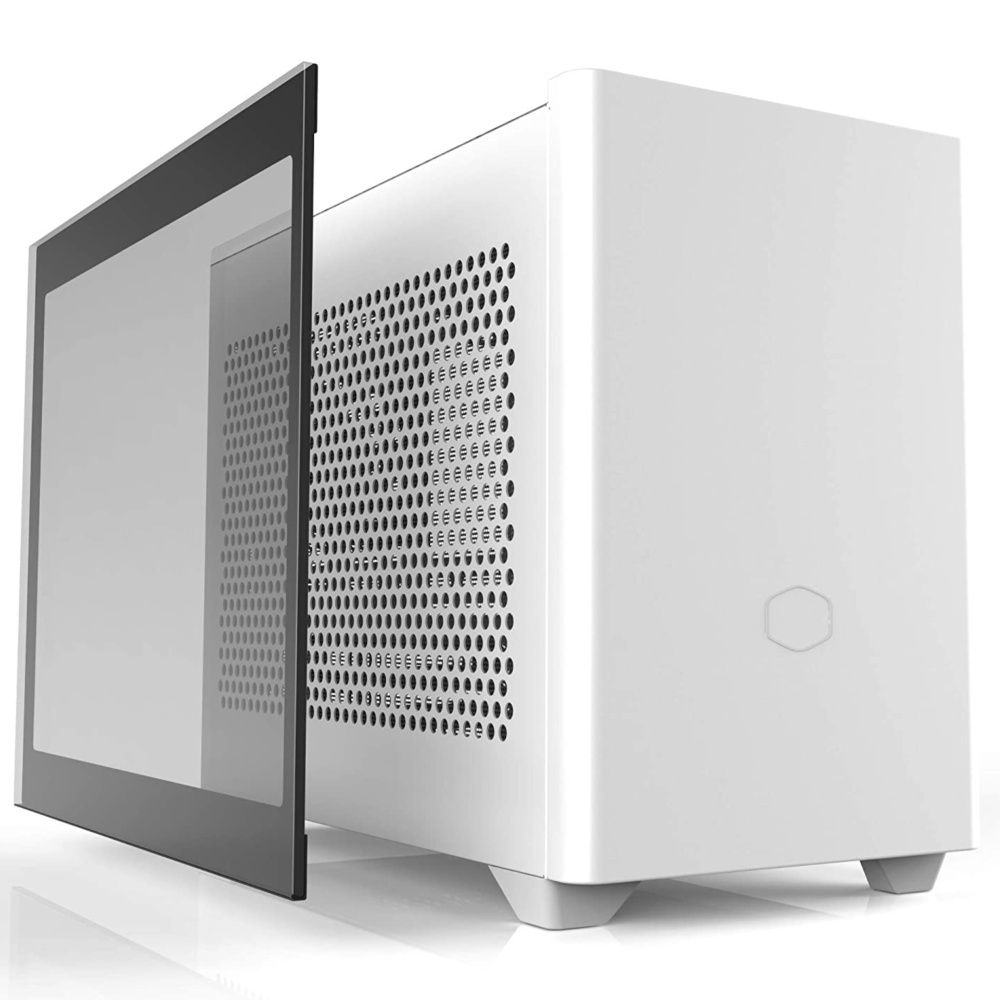
Cooler Master MasterBox NR200P
Best Small Form Factor PC Case for Airflow
$97 $110 Save $13
The Cooler Master MasterBox NR200P is a small form-factor white PC case with the features of an ATX case. The compact case can be completely taken apart for easy access to all components. It can accommodate up to a 240mm radiator at the bottom (with custom loops) while the side can take up to a 280mm radiator. It can also fit up to a 155mm tall CPU cooler and up to a 330mm long GPU. Two fans come included with the MasterBox NR200P.
- Brand
- Cooler Master
- Material
- Steel, Plastic, Mesh, Tempered Glass
- Graphics Card Size (Max.)
- 330mm
- 3.5″ Drive Slots
- 1 + 1 combo slot
- 2.5″ Drive Slots
- 2 + 1 combo slot
- Motherboard Size (Max.)
- mini-ITX
- Viewing Window
- Yes, optional tempered glass
- Color Options
- white, black
- Includes two SickleFlow fans
- Choice of using tempered glass or vented side panel
- Allows for vertical GPU mounting
- Missing USB-C port
- Rather plain-looking front panel
The goal of the Cooler Master MasterBox NR200P is to provide many of the capabilities of a full-sized ATX case in a mini-ITX chassis. Of course, buyers will need a mini-ITX or mini-DTX motherboard to use with this case. It’s ideal for compact and power-efficient builds. Even so, gamers can assemble a surprisingly capable gaming PC in the MasterBox NR200P, emphasizing accommodating full-sized graphics cards.
For a small case, some buyers may find that the MasterBox NR200P is on the pricey side, but they will receive a lot of extras in the retail box. Instead of making builders choose between tempered glass or vented left-side panels, Cooler Master ships both with the case. This allows users to enhance cooling performance since the one-panel option has extensive venting. The MasterBox NR200P is available in several colors, but its basic-looking front side makes the case look more like a server or home theater PC than a trendy gaming rig.
Even with the tempered glass side panel, adequate cooling remains possible thanks to the many other vents and flexible fan configuration options. The MasterBox NR200P ships with two 120 mm SickleFlow fans intended for its top panel and also allows for a maximum of seven fans to be installed around the chassis. CoolerMaster’s SickleFlow fans deserve some praise, with blade curves that maximize air pressure while remaining quiet. On the bottom and sides of the case, gamers can also place liquid cooling radiators of up to 240-280 mm. The result is a serious amount of airflow in a confined space that can help cool powerful CPUs and GPUs.
Often a frustrating exclusion with other cases, with the MasterBox NR200P buyers receive a riser cable that allows gamers to mount two-slot GPUs vertically. Three-slot graphics cards are welcome in the typical horizontal orientation, so gamers don’t have to compromise on performance. Mini ITX cases can be problematic when working with large components like graphics cards, but the MasterBox NR200P allows builders complete access since most of its panels are removable.
Complaints are usually minimal with buyers of the MasterBox NR200P, but the lack of a USB-C port can cause some inconvenience. Regardless, rivaling the expandability and cooling options of much larger cases, the MasterBox NR200P warrants consideration from anyone trying to save space on a gaming desk.
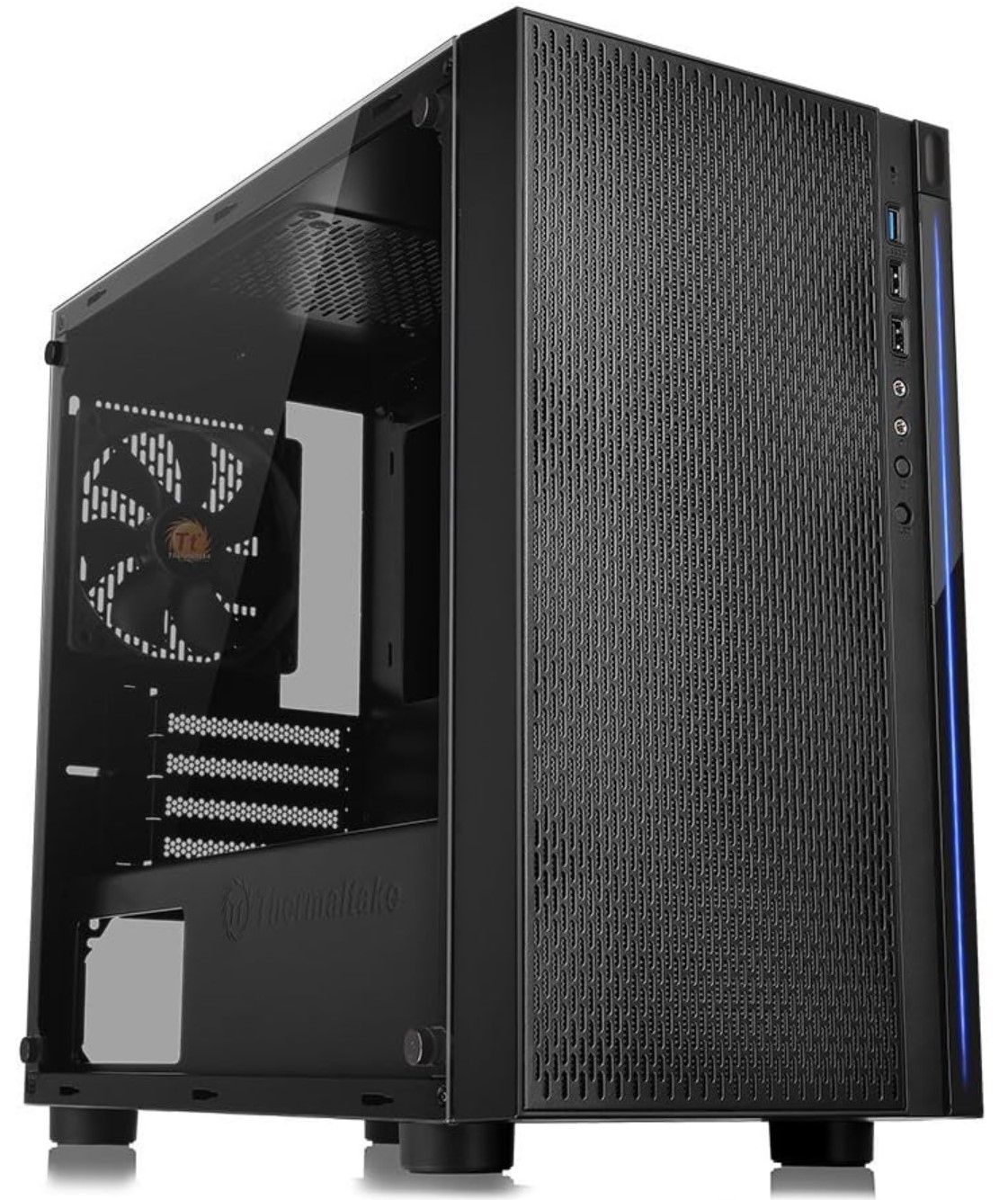
Thermaltake Versa H18
Best Budget PC Case for Airflow
$47 $55 Save $8
The Thermaltake Versa H18 is an excellent option for new PC builders or gamers assembling a compact, power-efficient rig. The Versa H18 is a Micro-ATX case with an acrylic side window allowing a clear view into the most impressive builds. The mesh front panel maintains an efficient airflow, and the cable routing gap makes hiding unsightly cables behind motherboards simple. Hidden drive bays have room enough for two 2.5-inch and two 3.5-inch storage devices.
- Brand
- Thermaltake
- Material
- SPCC, Tempered glass
- Graphics Card Size (Max.)
- 350 mm
- 3.5″ Drive Slots
- 2
- 2.5″ Drive Slots
- 2
- Motherboard Size (Max.)
- 6.7” x 6.7” (Mini ITX), 9.6” x 9.6” (Micro ATX)
- Viewing Window
- Yes
- Power Supply Size (Max.)
- 220 mm
- Substantial airflow with front mesh filter
- Frustration-free cable management
- Room enough for AIO liquid cooling
- Panels are rather thin
- Dated USB 2.0 ports on front I/O panel
Budget system builders also have plenty of options for cases that promote adequate airflow. The Thermaltake Versa H18 is one of the better solutions for buyers focused on affordable cooling options in compact systems. Supporting mini ITX and micro ATX motherboards, the Versa H18 is another case that makes intelligent use of limited chassis space.
Unlike some mini ITX cases with unusual designs, the Thermaltake Versa H18 is a prototypical mid-tower case that has been downsized. Besides the tempered glass panel, the most visible feature of the case is its large front mesh panel, which is responsible for drawing in ample airflow. On the right side of the front panel, buyers will find a series of ports and buttons that include one USB 3.0 and two USB 2.0 ports. A bit dated compared to most modern cases, fewer USB 2.0 ports and a higher speed USB 3.0 port would have been preferable, even with little surface area to work with. Finally, toward the right edge of the front panel, there is a blue LED light strip, though users can only turn it off and on and cannot change colors. Even so, it adds some flair to make a budget case seem a bit more premium.
The front mesh panel on the Versa H18 is not the only way the case keeps components at safe temperatures. Thermaltake reserves significant space behind the motherboard tray to make cable management easier. In a small chassis, thick cables can block airflow, so this compartment, plus the large PSU shroud, can effectively keep wires out of the way of fans. The case ships with one 120 mm on its rear panel, and there is the option for installing three 120 mm fans on its front side and top panel. Remarkably, builders can place up to a 280 mm AIO liquid cooling radiator near the front panel or a smaller 120 mm radiator at the back.
At its extremely affordable price point, some aspects of the Versa H18 don’t measure up to more expensive alternatives. Although the four mm tempered glass window feels substantial enough, the rest of the case relies on some thin panels that may not survive excessive abuse. Overall, even though the Thermaltake Versa H18 might not be the last case a buyer will own, nothing in its price bracket offers as many cooling possibilities.
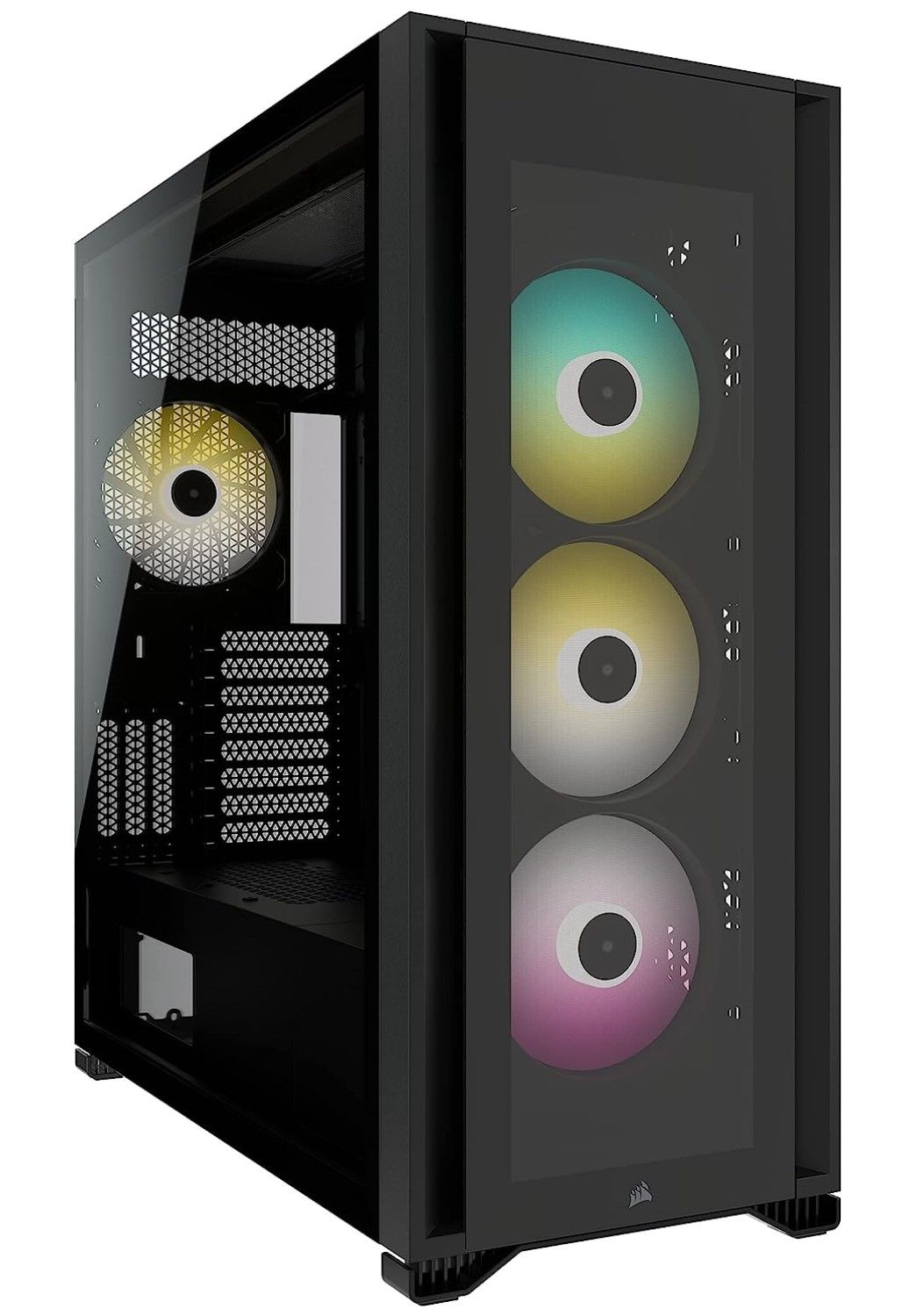
Corsair iCUE 7000X RGB
Best RGB PC Case for Airflow
$260 $290 Save $30
The Corsair iCUE 7000X is a full-tower ATX case that delivers on the features, style, and expansion options demanded from the best cases on the market. More than 50% larger than the typical mid-tower case, the iCUE 7000x has enough real estate for 12 120 mm fans and 3 360 mm radiators for liquid cooling systems. The ability to add 4 2.5-inch SSDs or 6 3.5-inch hard drives gives users enough storage space for years. The case also includes the Commander Core XT controller module to coordinate the iCUE-compatible lightning effects of the 4 included RGB fans.
- Brand
- Corsair
- Material
- Steel/Tempered Glass
- Motherboard Size (Max.)
- Micro ATX / ATX / Mini ITX / E-ATX
- Graphics Card Size (Max.)
- 450 mm
- 3.5″ Drive Slots
- 6
- RGB Lighting
- Yes
- Viewing Window
- Yes
- 2.5″ Drive Slots
- 4
- Looks stunning with dark tinted glass and plenty of RGB
- Almost unlimited possibilities for adding cooling
- Exceptional build quality with lots of metal parts
- Can achieve similar thermal performance for less money
- Despite size, doesn’t support dual PCs
Thermal glass isn’t the most conducive material for ventilation, but it’s popular among gamers since it shows off RGB effects without interruption. Even though the Corsair iCue 7000X RGB features dark-tinted glass on its front, top, and left side panels, its cooling capabilities are impressive. Large vents are scattered around its chassis to compensate for the lack of mesh, but the four included 140 mm RGB fans are responsible for much of the case’s airflow. The unique design of these fans allows them to concentrate powerful streams of air and reach all corners of the expansive enclosure.
The iCue 7000X RGB is a beautiful high-end full-tower case that consists mostly of metal parts. Along with excellent build quality, the larger form factor means the case is a playground for adding additional cooling. Builders can install up to three 360 mm AIO liquid cooling radiators or utilize the space on the top of the chassis for more fans. Even side mounting fans, which is impossible in most smaller cases, is a reality with the iCue 7000x RGB. Modifying the configuration of the case is also straightforward since its side panels swing open on hinges.
To further justify its premium price, the iCue 7000X RGB ships with Corsair’s own RGB controller box, coordinating the lighting of the included fans. Buyers can connect additional illuminated fans or LED strips and sync these effects with Corsair’s RGB gaming keyboards and mice.
Some disappointments with the iCue 7000X RGB include the fact that a builder can’t install two systems in the case despite its size. Cheaper full-tower cases like the Phanteks Enthoo Pro 2 offer this option, but Corsair keeps more of its chassis open for airflow. Also, the thermal performance of the iCue 7000X RGB tops most cases that are heavy on tempered glass, but buyers can spend considerably less on an alternative with mesh materials. Nevertheless, the included RGB components and impressive cooling performance make the iCue 7000X a standout among full-tower cases.
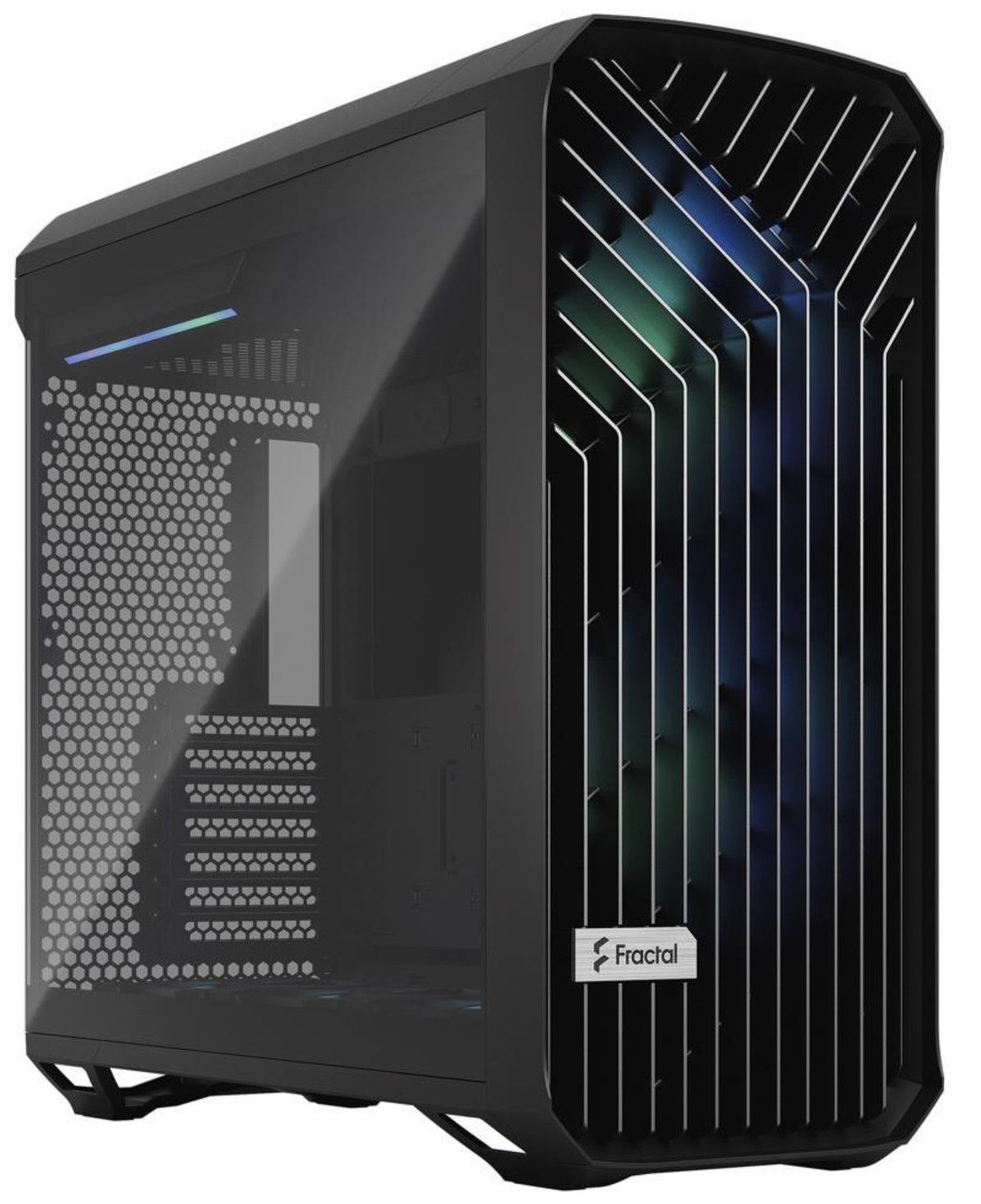
Fractal Design Torrent
Best Quiet PC Case for Airflow
The Fractal Design Torrent is a modern-looking PC case that features a large base for mounting up to three fans that direct the airflow upwards toward the GPU. As for radiator support, the Torrent can accommodate up to 420mm radiators at the front as well as the bottom. It comes with a total of five case fans, two 3.5-inch drive bays, and four 2.5-inch drive mounts. Additionally, Fractal Design offers a Nexus 9P Slim PWM fan hub, a GPU bracket, cable straps, and more with the Torrent.
- Brand
- Fractal Design
- Material
- Steel, tempered glass
- Motherboard Size (Max.)
- E-ATX
- Graphics Card Size (Max.)
- 423mm
- 3.5″ Drive Slots
- 2
- RGB Lighting
- Yes
- Fan Controls
- Yes
- Viewing Window
- Yes, tempered glass
- 2.5″ Drive Slots
- 4
- Color Options
- Black, White, Grey with Light Tint, Black with Dark Tint, Black with Light Tint, White with Clear Tint
- Large but efficient fans are extremely quiet
- Top-mounted PSU allows for bottom-mounted fans
- Open chassis makes building in case easier
- Fans do get louder at maximum speeds
- A lot of plastic used for high-end case
Contrary to what may seem logical, the most quiet cases like the Fractal Design Torrent can facilitate ample airflow. This mid-tower ATX case can effectively cool components using a pair of large 180 mm fans on the front panel. These unusually thick fans produce more air than smaller fans while using less energy. Also, the Fractal Design Torrent is easily recognizable thanks to its front cover, a grill with huge openings that allow more air in and out of the case than most mesh materials.
Another trademark feature of the Torrent is its PSU shroud mounted at the top of the case rather than at the bottom. This power supply positioning has numerous consequences for airflow and cable management. With the bottom of the case unobstructed, the Torrent can include three 140 mm fans blowing cool air upwards at GPUs and CPUs. Unfortunately, while case builders can place large AIO liquid cooling radiators on the front or bottom of the case, the top PSU shroud limits cooling options at the top of the chassis.
With the PSU shroud effectively hidden away, the inside of the Torrent looks more spacious than the typical case. This extra room allows air to move unobstructed in the case, making installing large components like graphics cards less frustrating. However, with power supply cables originating from an unusual location, buyers may struggle to find the best pathways to reach any hard drives below.
Gamers who tax their systems will want to set up a fan curve since, at full load, the five included fans start to become noisy. The only other complaint with the Torrent is that a surprising amount of plastic is used around the case. Considering its considerable price tag, this might cost it some support from buyers who expect a slick-looking case to have superior build quality. All things considered, benefiting from an open design and incredibly potent fans, the Fractal Design Torrent ranks among the top cases for thermal performance.
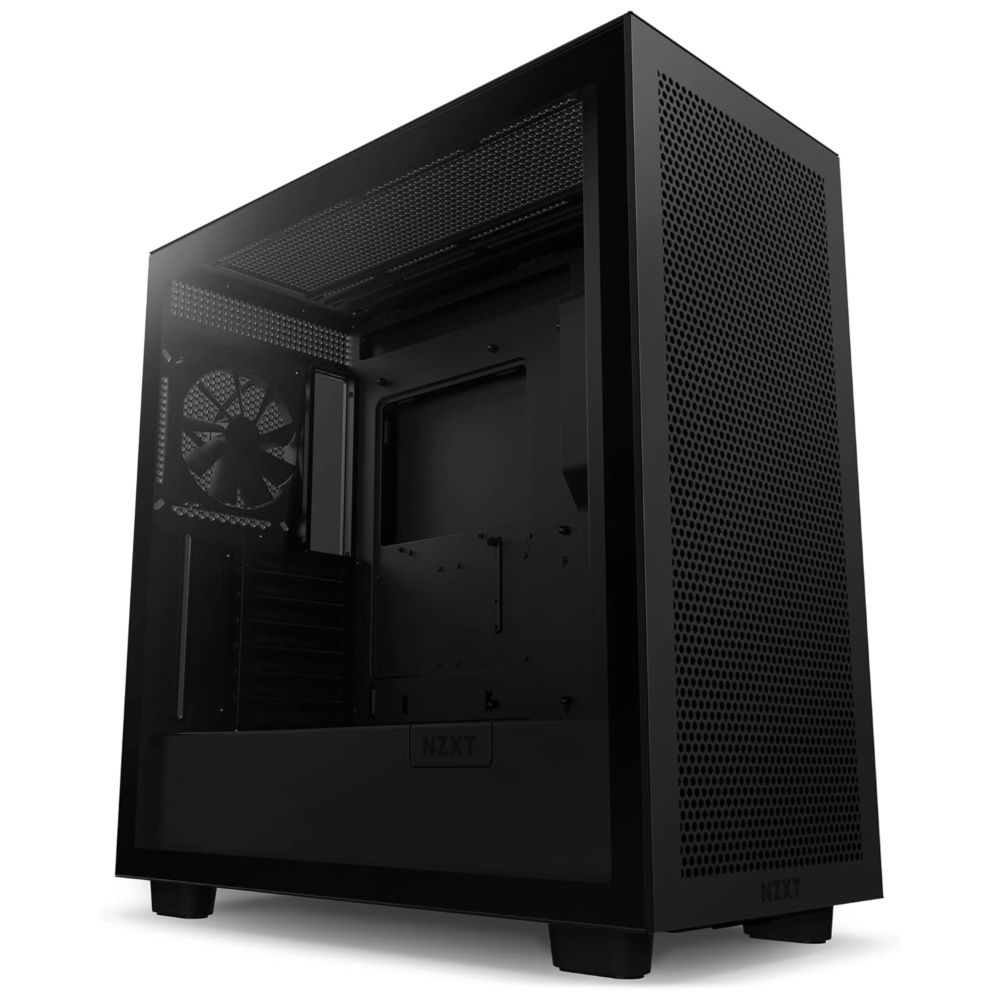
NZXT H7 Flow
Best High Airflow PC Case for Cable Management
The NZXT H7 Flow is a mid-tower PC case that accommodates mini-ITX, micro-ATX, and ATX motherboards. It comes with 2 F Series Quiet 120mm fans, 2 3.5-inch drive bays, and 6 2.5-inch bays. It also supports up to a 360mm radiator at the front and top, and up to 140mm at the rear. The front panel is perforated for uninterrupted airflow and there is a tempered glass side panel as well.
- Brand
- NZXT
- Materials
- SGCC Steel, Ultra-clear Tempered Glass, Dark Tinted Tempered Glass
- Dimensions
- 505x230x480mm
- Fans Included
- 2 F Series Quiet 120mm fans
- Many dedicated pathways for cables
- Perforated front and top panels promote airflow
- Easy to disassemble and work in
- Quiet despite open design
- Minimalist front I/O panel
- Basic look of non-RGB version may not appeal to gamers
Cable management may not be the most decisive factor when it comes to airflow in cases, but it should be a consideration nonetheless. Too many cables running near fans and vents can block air circulation without proper routing. Also, builders often add more fans to enhance airflow, which only creates potentially messy wiring. The NZXT H7 Flow is an unassuming mid-tower case built with these concerns in mind.
NZXT has placed numerous wide cable channels behind the motherboard tray to make assembling a new rig easier. In addition, buyers will encounter a series of velcro straps and hooks to guide them as they connect cables to and from a power supply. The Elite version of the H7 even has an additional removable bracket near the front panel. In fact, most of the H7 Flow can be disassembled so that builders can explore every possible option for hiding cables.
Many cases employ ultra-fine mesh materials to allow airflow into a chassis, but the NZXT H7 Flow takes a different approach. The front and top of the mid-tower case utilize large metal panels with noticeable perforations. While the fact that NZXT doesn’t make much effort to hide these openings might not appeal to gamers searching for a cohesive look, its cooling performance is outstanding. The two F Series Quiet 120 mm fans included with the H7 Flow are sufficient when combined with the porous metal panels. Buyers can add a fan behind the front panel and three fans along the top of the case or opt for up to 360 mm AIO liquid coolers.
One complaint buyers may have with the H7 Flow is that its front I/O panel lacks a reset button or hard drive activity LED. Still, this simplicity follows the theme of the non-RGB version of the case, which blends in with setups without any fanfare. Ultimately, the NZXT H7 Flow is the best PC case for airflow for buyers who value quiet cooling performance without an abundance of fans.
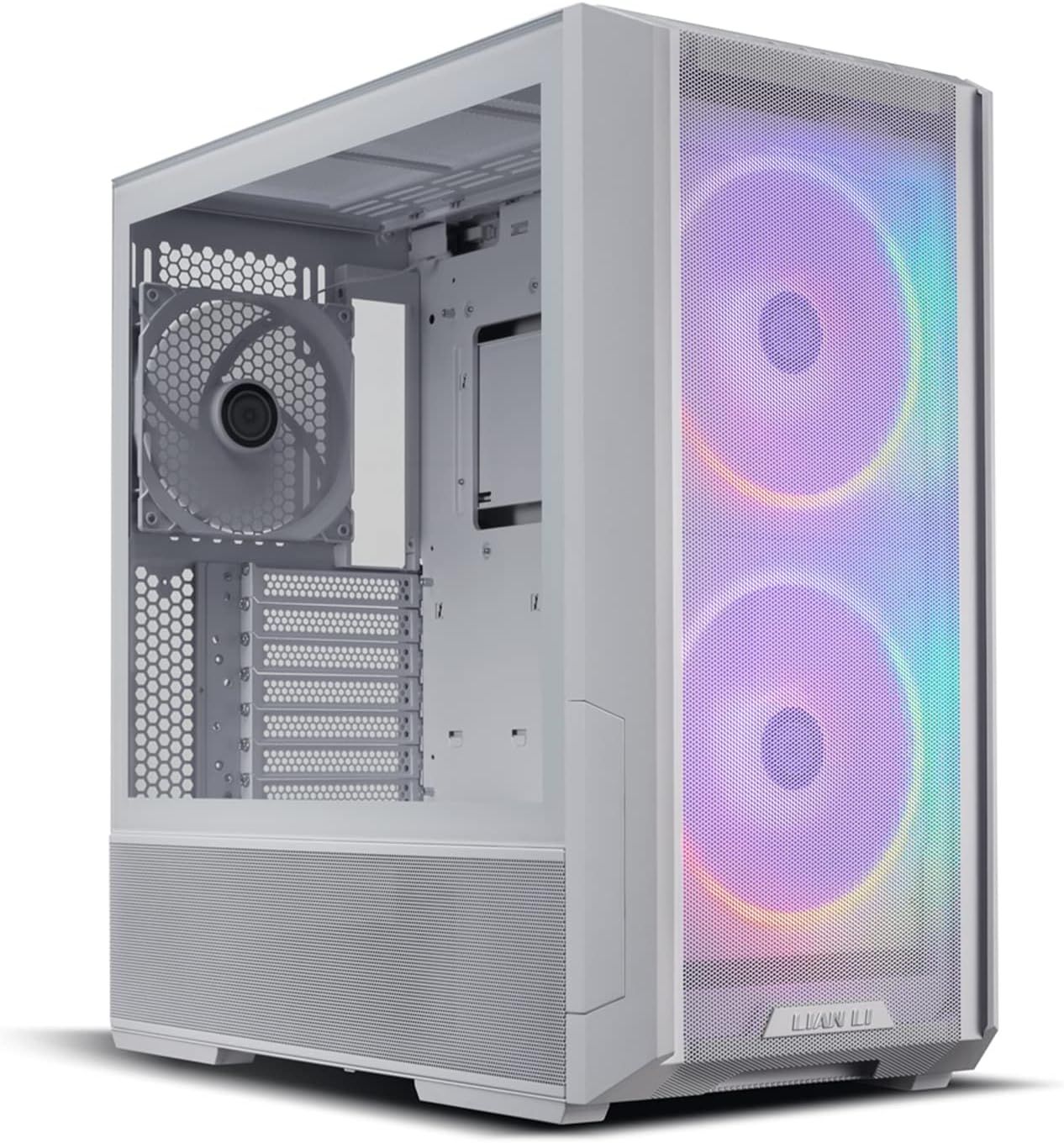
LIAN LI LANCOOL 216 PC Case
Best White PC Case for Airflow
The LANCOOL 216 is a mid-tower case with all-around mesh panels for optimal airflow. Thanks to its modular rear panel, it can be optimized for air or water cooling. It includes 2 x 160mm and 1 x 140mm pre-installed PWM fans and an innovative rear PCIe fan bracket to maximize airflow.
- Brand
- LIAN LI
- Material
- Steel / 4.0mm Tempered Glass
- Motherboard Size (Max.)
- E-ATX (Under 280mm)
- Graphics Card Size (Max.)
- 392mm
- 3.5″ Drive Slots
- 2 x 3.5” HDD
- RGB Lighting
- Yes
- Viewing Window
- Yes
- 2.5″ Drive Slots
- 6 x 2.5″ SSD slots
- Power Supply Size (Max.)
- ATX (Under 220mm)
- Exterior Dimensions
- (D) 480.9mm x (W) 235mm x (H) 491.7mm
- Extensive use of mesh on multiple sides
- Rear PCIe fan bracket helps cool GPUs
- Amazingly customizable case for its price
- RGB controller is a separate purchase
- PCIe fan could block access to other components
In a sea of black gaming gear, white cases have become increasingly popular choices for rigs. Many cases now offer white as an option but don’t always fully commit to this color scheme. Fortunately, this Lian Li Lancool 216 version is nearly completely white, inside and outside of its mid-tower chassis. However, it also excels in cooling performance due to the extensive mesh materials around the case.
Having tempered glass on one side of a case doesn’t have to sacrifice airflow completely. The Lancool 216 offers the best of both worlds, with a large mesh section below its left glass panel. Mesh is seen throughout the rest of the case, with air freely circulating around its front and top sides. Taking a cue from other mid-tower cases like the Fractal Design Torrent, the Lancool 216 places two 160 mm fans on its front instead of a trio of smaller blowers. In addition to a 140 mm fan on its rear panel, Lian Li also supplies a PCIe fan bracket where builders can add another 120 mm fan near a GPU. The potential fan configurations and mesh openings lead to the Lancool 216 producing much more airflow than similarly sized competitors.
It’s not a rule that white cases have to feature RGB fans, but buyers who embrace the color usually aren’t afraid of making a statement. The Lancool 216 borders on budget territory, so there are sacrifices regarding its RGB capabilities. Buyers will have to pay slightly more for the manufacturer’s integrated ARGB controller, or they can connect fans and LED strips to motherboard headers.
The Lancool 216 is already an impressive mid-tower case, but its modular nature further elevates this enclosure’s stature. System builders can install motherboards in two locations, with a top position ideal for air cooling and a lower spot better suited for liquid cooling setups. Also, the entire front I/O panel can move to the bottom of the chassis to accommodate any build.
Among all white-colored contenders, the Lian Li Lancool 216 is the best PC case for airflow, benefiting from maximum mesh and a unique fan configuration.
Deciding on the Best Case for Cooling Components
This guide has demonstrated that manufacturers keep finding innovative ways to maximize airflow in PC cases. If doubts remain about what case is right for a new build, remember to focus on these critical elements first:
Filters and Vents
It’s hard to argue with the cooling performance that mesh materials allow for. The Lian Li Lancool 216 realizes the full potential of mesh, employing it on three sides of the case. In conjunction with a rear PCIe fan bracket, no critical component inside the Lancool 216 is blocked from airflow.
While mesh is a popular way to keep air circulating into and out of a chassis, the Corsair 4000D Airflow takes a slightly different approach. This mid-tower ATX case features enlarged triangular cutouts on its front panel and throughout its chassis, inviting airflow and giving the enclosure a unique appearance.
Case Fan and AIO Liquid Cooling Support
Cases often come with two or more case fans, but the most powerful gaming rigs may require additional cooling. The MSI MPG Gungnir 300R Airflow is an example of a mid-tower case that not only ships with four ARGB fans but has room for eight more fans and two 360 mm liquid coolers. Even more interesting is its included vertical GPU mounting hardware, complete with an additional fan that sits next to PCI slot brackets.
Form Factor
The size of the case that a buyer targets can impact what cooling options are available. Still, a mini ITX case like the Cooler Master MasterBox NR200P maximizes its available space with the ability to install seven fans around its chassis. Of course, full-tower cases will have an advantage with thermal performance because of the sheer amount of room in the enclosure. The Phanteks Enthoo Pro 2 is a generously sized case that provides enough ventilation and cooling for two adjacent systems.
Cable Management
Some gamers may not realize that poor cable management can also threaten airflow. Since this problem is more common in compact cases, the mini ITX Thermaltake Versa H18 ensures that there is plenty of room behind its motherboard for proper cable routing. Smaller cases like the Versa H18 also make intelligent use of the shrouds covering PSUs with additional locations to hide bulky wiring.
The modestly sized NZXT H7 Flow demonstrates other simple but effective ways to tidy wiring. System builders will find a series of large channels to disguise the most unsightly cables and many velcro straps and hooks.
GameRant believes that the Corsair 4000D Airflow provides the best combination of ventilation and support for additional case fans and AIO liquid coolers. Still, depending on a particular buyer’s components and cooling needs, the best PC cases for airflow include the many other candidates discussed in this guide.
FAQ
Q: Do PC cases matter for airflow?
Even if a CPU cooler has the most direct effect on the stability of a system, the hot air generated by components needs a place to escape. Well-ventilated PC cases allow cooler air to enter through perforated front panels to reduce temperatures while providing exhaust points for warm air.
Q: What size PC case should I buy?
Whether buyers should purchase a mini-ITX, mid-tower, or full-tower case depends on which motherboard/CPU combo they select for a PC build. However, most medium-sized and large cases accommodate a wide range of motherboard sizes, so the choice also depends on available desk space, storage requirements, and budget.
Q: How do I know if my components will fit in a PC case?
Even smaller PC cases are designed to accommodate the most common components in a condensed area. Still, it’s best to check the specs of a case to ensure that long graphics cards will fit and that storage bays will hold a suitable number of hard drives.

/cdn.vox-cdn.com/uploads/chorus_asset/file/25263502/STK_414_AI_B.jpg)
